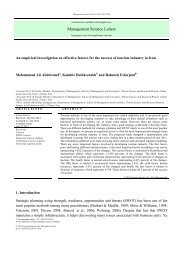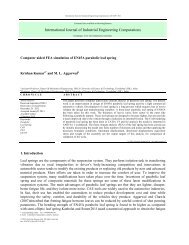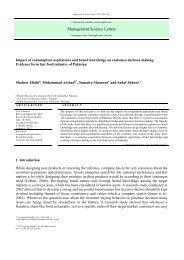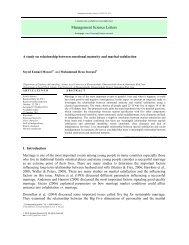PDF (276 K) - Growing Science
PDF (276 K) - Growing Science
PDF (276 K) - Growing Science
You also want an ePaper? Increase the reach of your titles
YUMPU automatically turns print PDFs into web optimized ePapers that Google loves.
330<br />
Gij ≤ A. X<br />
∀ i, j;<br />
ij<br />
(13.6)<br />
The number of variables and constraints in the liberalized model are presented parametrically in<br />
Tables 1 and 2 respectively, based on the variable indices.<br />
Table1<br />
The number of variables in the liberalized model<br />
Variable<br />
Xij<br />
Ti<br />
Ei<br />
Qij<br />
Sum= 2 (N) +9 (N×J)<br />
Count<br />
N×J<br />
N<br />
N<br />
N×J<br />
Variable<br />
Table 2<br />
The number of constraints in the liberalized model<br />
Con.<br />
Count<br />
Con.<br />
(2)<br />
(3)<br />
(4)<br />
(5)<br />
(6)<br />
(7)<br />
(8)<br />
N<br />
J<br />
N<br />
N<br />
N×J<br />
3(N)+6(N×J)<br />
N<br />
(10)<br />
N×J<br />
Sum=20(N×J) + (J) + 10(N)<br />
5. Numerical examples<br />
Mij<br />
Fij<br />
Bij<br />
Gij<br />
(11)<br />
(12.1)<br />
(12.2)<br />
(12.3)<br />
(12.4)<br />
(12.5)<br />
(12.6)<br />
(12.7)<br />
Count<br />
N×J<br />
N×J<br />
N×J<br />
N×J<br />
Count<br />
N×J<br />
N<br />
N×J<br />
N×J<br />
N×J<br />
N×J<br />
N×J<br />
N×J<br />
Variable<br />
Rij<br />
XPij<br />
XMij<br />
Con.<br />
(12.8)<br />
(13.1)<br />
(13.2)<br />
(13.3)<br />
(13.4)<br />
(13.5)<br />
(13.6)<br />
Count<br />
N×J<br />
N×J<br />
N×J<br />
To validate the proposed model, a numerical example in a small size with randomly generated data is<br />
solved by a branch-and-bound (B&B) method under the Lingo 11.0 software on an Intel®<br />
CoreTM2.4 GHz Personal Computer with 4 GB RAM. Table 3 presents the information related to<br />
each job in this example and contains processing time, due date, the penalty of earliness, tardiness,<br />
and interruption as well work-in-process holding cost.<br />
Table 3<br />
Job information<br />
Job<br />
number<br />
Processing<br />
Time<br />
Due date<br />
Ideal Start<br />
Time<br />
Earliness<br />
Penalty<br />
Tardiness<br />
Penalty<br />
Interruption<br />
penalty<br />
Work-in-process<br />
holding cost<br />
1 4 9 6 80$ 60$ 5$ 1$<br />
2 6 12 7 60$ 40$ 8$ 2$<br />
3 4 12 9 80$ 90$ 6$ 5$<br />
4 5 17 13 70$ 80$ 3$ 2$<br />
5 5 29 25 60$ 50$ 2$ 1$<br />
6 3 29 27 30$ 60$ 4$ 2$<br />
The objective function value (OFV) obtained after 36134124 iterations in a CPU time 1:16’:21” is<br />
presented in Table 4. Fig 4 shows the positions in which the jobs are processed, the starting and<br />
completion time of each job and the interruption interval for each job. For example, job 3 is started to<br />
be processed in position 8, interrupted in position 9 and started again to be processed in position 10<br />
until it is exactly terminated in its due date 12. As due date is 12 and its ideal starting time is 9, job 3<br />
Count<br />
N×J<br />
N<br />
N×J<br />
N<br />
N×J<br />
N×J<br />
N×J








